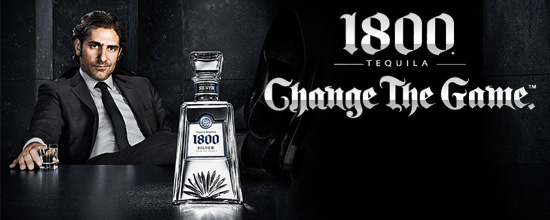Silver Tequila: Greatest Scam on Earth?
Silver tequila is being marketed as an upscale super premium when, in fact, it's the lowest form of tequila.
Lately, there’s been a huge push to market silver tequila, with Patrón seemingly pioneering the campaign and Jose Cuervo’s 1800 brand rushing to claim their spot.
The upshot of the effort is that silver is a premium sort of tequila and these brands in particular are “ultra premium.”
But here’s the thing: Traditionally, silver has been at the bottom of the tequila food chain, suitable only for mixing or cheap infusion of alcohol into the system. Historically, there have been three categories of real (i.e., 100 percent blue agave) tequila:
- White or Silver: Unaged or aged for mere days.
- Resposado (rested): Aged anywhere from two months to a year in oak barrels
- Añejo (aged): Aged at least one year in oak barrels
Lately, a Gold tequila has been added — it’s quite literally White/Silver tequila with caramel coloring added — and Extra Añejo, established a few years back, which must spend at least three years in the barrel.
Suddenly, though, we’re led to believe that Silver is what sophisticates drink. Which, if it’s what your palate prefers, is fine. But, just from the descriptions of the products above, it should be obvious that it should be the cheapest variety because all the others start as silver and then have additional effort put into them.
Yet, at least in these parts, Silver and Resposado varieties of the top brands (Patrón, Jose Cuervo, and 1800) are priced identically. Añejos, which are intended for sipping, are radically more expensive.
So, either this is the world’s shrewdest marketing campaign or there’s something new going on with tequila that I’ve missed.







There are some very drinkable blancos, and some of my agave head friends hold that they express the “true nature of tequila” – whatever that means – better than the reposados or anejos. However, they think this recent crop of premium blancos is mostly marketing and I have to agree. Since most of them end up in margaritas, they’re more affectation than sophistication.
I concur. Gringo.
Sounds like a page from Corona, make booze with the cheapest ingredients, using the cheapest methods and then leave it to marketing to take care of the rest.
Oh yeah, and convince people that adding fruit is mucho cooler.
A triumph of marketing right up there with convincing people that the worst seats in a movie theater should cost the same as the best seats in a movie theater.
Dave,
I’ve never known it any other way domestically, although movie theaters in Germany and Egypt priced seating in the same manner we do for plays. Oddly, people seem to have no idea that there’s a preferred seat — with some racing to the back, others the middle, others the front row.
Somebody once told me that anyone who buys an American made vodka other than Jakoff (TM and made up) is wasting his or her money as all vodka made in the US is made the same way by law. Anyone know if that’s true?
No, the biggest scam on earth is “premium” vodka, which is ridiculous, since vodka is supposed to be oderless, colorless and tasteless except for the ethanol. And hundreds of taste tests have shown that 50-75 dollar vodkas don’t do any better than a 10 dollar bottle of smirnoff. It’s ALL marketing.
Liquor of any sort is near the bottom of my greatest scams list. Our modern government ranks at the top.
Sam,
Nope, not true. Well, actually, i don’t know quite knowwhat you meant by ‘made the same way.” However, you can buy American vodkas made from wheat, potatoes, rye, grapes, and so on. Do any of these taste at all diferent? No, but why spend $10 on a bottle of vodka when you could spend $100?
It’s been that way in the U. S. since the 1920s. Single pricing for movie seats was a conscious innovation. A truly great scam.
“Well, actually, i don’t know quite knowwhat you meant by ‘made the same way.”
Ah, well, according to him, it’s all made from spuds. Guess not. But, “Do any of these taste at all diferent? No, but why spend $10 on a bottle of vodka when you could spend $100?” Why, indeed?
In this thread: “People who like different things than I do are suckers, man”.
In this thread: “People who like different things than I do are suckers, man”.
Not at all. It’s perfectly conceivable that a lot of people prefer unaged tequila to aged. The scam is marketing the unaged as if it were somehow “premium” and charging the same as for the aged. Especially when, two or three years ago, the unaged was markedly cheaper.
There are other examples of this that are more benign. Renaming “dolphin fish” as “mahi mahi” makes it a hell of a lot easier to sell. But this one is just capitalizing on people’s ignorance.
This post is relevant to my interests.
Silver tequilas of all varieties are harsh and do not give the pleasing warmth of an aged tequila so much as they cut the esophagus on the way down. If the sensation of razor blades moving about in my stomach is the “essence of tequila,” I’ll take the wimpy and more expensive añejo any day.
The only thing I would use silver tequila for is infusion. Pineapple chunks and mint leaves can be left to soak in tequila for about a month (in a refrigerator). Strain it out very well through a mesh filter and then a cheesecloth. That, you can drink.
Speaking of things bibulous, see this story in the Times: Buried Treasure in Baltic Brings Back Vintage Taste — headline’s a bit misleading, the stuff was buried, it was in the hold of a sunken ship.
“the stuff wasn’t buried” 0f course
Blanco Tequilas are the truest expression of blue agave, second only in aromatic and flavor complexity to scotch. Tur, most of the “big name ” brands sell “pseudo-premium” tequilas based purely on marketing tactics, but superior tasting blancos DO exist, and they are more expensive because they are done in a truly artisanal way.
Lets start by stating Tequila is protected by a DOT (Denomination of origin) as many other quality spirits and products are (Cognac, Champagne, Brandy de Jerez, Armagnac, etc…), and follow very strict production guidelines. The only major “flaw” is that because of the economic interests of big companies, tequila is allowed to exist under 2 main “categories”: the MIXTO (made only with less than 51% sugars from blue agave plants) and the REAL tequila category, called “100% agave” and as the name implies, all alcohol comes from the distilled sugars of Tequilana Weber blue variety agave (there are 9 types of Tequilana Weber agave, but the Blue type is the ONLY one allowed for legal tequila making)
A REAL Blanco tequila starts as a 100% agave Blanco, thats for sure.
Gold tequila has existed from a long time ago, and not all of them are simply “painted” mixto blancos: take the example of Casa Noble Gold, available around 2000-2001, the only one to offer not just 100% agave status, but also 6 weeks or real aging inside oak barrels, and triple distillation. Getting your hands on one of this rare and elusive bottles is quite a feat, and virtually all who have tasted it consider it a masterpiece of tequila craftsmanship.
Understanding how tequila is actually produces makes it easier to understand why some blancos are so exceptional and cost higher that the rest. Brands who use more mature agaves (8 to 12 years of age), cook them in stone ovens (using over 40 hours to cook the agave instead of pressure cookers that take 8 hours), grind them in tahonas ( those big stone wheels used to extract the sweet juice of cooked agaves, ferment the juice naturally with no added sustances to speed up the sugar-to-alcohol conversion (come brands take up to 5 days to finish the fermentation!) , and more importantly: how they perform distillation.
Distillation is a key element in understanding a steep difference in cost of production. Big industrial operation use big columns or continuous distillation processes, while a few still do it batch by batch. The size and sophistication of the pot stills is also important because it allows for a more precise manipulation of the alcohols (remember that fermentation produces various types of alcohols, from very simple to quite complex) and each one has its own physical and chemical properties, such as boiling point…etc), and a master distiller should regulate this process carefully. You have to get rid of a considerable amount of the distilled product: the “heads” being the first alcohols to condense and being so volatile and simple makes them very toxic and harsh, en then the “tails” which is the final portion of the distillation process and contains more complex alcohols, dead yeast, vinazas, etc… and in all its a very foul-tasting and smelly concontion that tequileros must get rid of. The more heads and tails you leave in, the more bottles you will get…and the worse tequila blanco you will taste.
Yes, there are many expensive “super-hyper-uber premium” blanco brands on the market…but in general, if they come from a big distiller that puts a premium on volume instead of quality, chances are you are over-paying for some average tequila that has been conditioned to taste and feel “nice”.
My advice is for you to learn the wonders of truly premium artisanal tequila, not because of the sticker price, but because of the way it smells, feels and tastes. Brands like Casa Noble, Ocho, La Fortaleza, Siete Leguas, Tesoro de Don Felipe (the Mexican stuff), Oro Azul, Corrido, Siembra Azul, Fina Estampa, Paqui, 1921, T1, Centinela, Charbay, Tapatio, just to name a few., will put a radically different perspective in your tastebuds and your mind as well.
Always check the label: look for the “100% agave” legend, look for the NOM number (Tells you WHERE that tequila is actually being produced) and learn hot to warm up your mouth and tastebuds instead of just “shooting” tequila. Learning how to do this will open a fantastic new door in your quest for oral pleasures.
Never forget: not all tequilas are made the same, and YES: some are much better and worth the price than others.
Enjoy.
Thank you Dave G! That’s the response I wanted to give but could not word it nearly as perfectly or completely. A great Tequila 101!